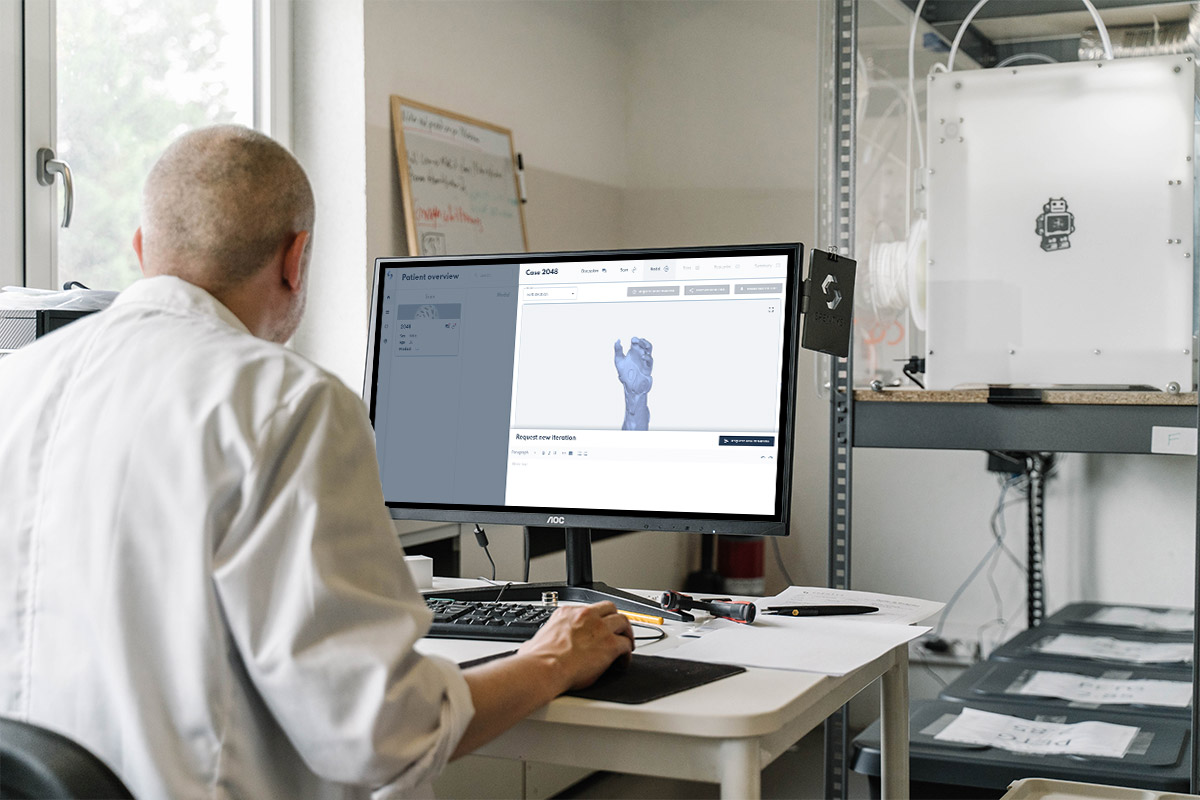Complications of a traditional cast
Casting is an immobilisation procedure that is often applied for closed, reduced or non-displaced fractures (1). Immobilisation is useful for various reasons: it keeps the bone in the right position, protects the surrounding structures from injury and reduces pain. However, if additional swelling is expected, which is the case for all fractures less than 2 to 3 days old, splinting is the preferred method to provide immobilisation. Some fractures require acute casting, despite the risk of additional swelling. Examples for which acute casting might be necessary include some fractures with strong muscle forces across the broken bone, e.g. a tibia fracture with contraction of the quadriceps muscle, or some fractures with dislocation, e.g. a displaced wrist fracture. In this case, the cast should be split and wrapped with an elastic band for the first few days. If significant swelling is present, there is a risk that the cast might become too loose. For this reason, splinting is also preferred in these cases (2).

Although casting is sometimes inevitable, it does come with some risks. Complications due to immobilisation include joint stiffness, disuse syndrome, muscle atrophy and thrombosis. Secondly, some complications are specific to traditional casts. The most important ones are a compromised blood supply (if the cast is applied too tightly or it becomes too tight as a result of swelling), compression neuropathy and acute compartment syndrome (1). These complications will be discussed further in this article.
The first complication, acute limb ischemia, is characterised by the six P’s: pain (usually distally in the extremity), poikilothermia (the skin feels cool), pallor, pulselessness, paresthesia and paralysis. If acute limb ischemia is suspected, the cast should be removed so that a complete examination of the limb can be performed and the degree of ischemia can be documented: viable, marginally threatened, immediately threatened or irreversible ischemia (3).
In like manner, compression due to an excessively tight applied cast can also lead to compression neuropathy. When ischemia occurs, nerve conduction will be slowed and will eventually be blocked entirely. Symptoms comprise pain and weakness. Of course, the specific symptoms depend on the nerve that is being compressed, e.g. a peroneal nerve compression can cause an acute foot drop (4).
A third, important complication of the traditional cast is compartment syndrome. Compartments in the limbs are divided by strong, fascial membranes and contain muscle groups. When the pressure inside a compartment increases and causes the circulation and function of the content of the compartment to be compromised, compartment syndrome occurs (5). The most important symptom is pain. Pain that provokes a burning feeling, pain that appears after a delay of time or increases in severity or pain when a passive stretch is performed on the compartment should be reminiscent of compartment syndrome. Other symptoms include paresthesia and paralysis, but these are late symptoms.
The presence of arterial pulses does not rule out the diagnosis of compartment syndrome, since the pressure in the compartment is almost always lower than the systolic blood pressure. Additionally, the tissue can be visibly swollen, and it can have a tense feeling on palpation. To diagnose of compartment syndrome, it is important to have a clinical suspicion. Pulse oximetry can be used, but it has a very low sensitivity (40%). Another technique that is being used more and more is near-infrared spectroscopy (NIRS), which allows measuring the oxygen saturation in tissues at depths up to 10 cm. However, the most reliable method to diagnose compartment syndrome is to measure the pressure directly in the compartment using needle manometry. When the diagnosis is confirmed, any constricting bandages or casts should be removed, and the limb should be kept in neutral elevation. A fasciotomy (a procedure in which the fascia is cut to relieve the pressure in the compartment) should be performed, ideally within 6 hours of onset. The pressure should be checked again to confirm that it has been reduced. The patient should receive continuing debridement of dead tissue, analgesia, prophylactic antibiotics and monitoring of the renal function. Other treatment options include the use of mannitol (to decrease the tissue oedema) and hyperbaric oxygen (to increase the tissue oxygenation) (6).

Besides these complications, traditional casts also have some practical disadvantages that can have an impact on the patient’s quality of life, such as sweating, having to carry around heavy weight and not being able to take a shower. Additionally, the cast has to be removed and changed completely when an examination or x-ray is necessary. Immobilisation devices by Spentys offer a solution to these difficulties: they are up to 10 times lighter than a traditional cast, they are waterproof, they offer aeration, and they are easy to adapt and to remove (7).
As shown above, casting is an immobilisation procedure that is sometimes necessary but has specific risks, namely acute limb ischemia, compression neuropathy and compartment syndrome. Furthermore, a traditional cast can also cause some practical problems. Therefore, it is vital to ensure that there is a good indication to apply a conventional cast and to be attentive towards the complications.


Complications of a traditional cast

Casting is an immobilisation procedure that is often applied for closed, reduced or non-displaced fractures (1). Immobilisation is useful for various reasons: it keeps the bone in the right position, protects the surrounding structures from injury and reduces pain. However, if additional swelling is expected, which is the case for all fractures less than 2 to 3 days old, splinting is the preferred method to provide immobilisation. Some fractures require acute casting, despite the risk of additional swelling. Examples for which acute casting might be necessary include some fractures with strong muscle forces across the broken bone, e.g. a tibia fracture with contraction of the quadriceps muscle, or some fractures with dislocation, e.g. a displaced wrist fracture. In this case, the cast should be split and wrapped with an elastic band for the first few days. If significant swelling is present, there is a risk that the cast might become too loose. For this reason, splinting is also preferred in these cases (2).

Although casting is sometimes inevitable, it does come with some risks. Complications due to immobilisation include joint stiffness, disuse syndrome, muscle atrophy and thrombosis. Secondly, some complications are specific to traditional casts. The most important ones are a compromised blood supply (if the cast is applied too tightly or it becomes too tight as a result of swelling), compression neuropathy and acute compartment syndrome (1). These complications will be discussed further in this article.
The first complication, acute limb ischemia, is characterised by the six P’s: pain (usually distally in the extremity), poikilothermia (the skin feels cool), pallor, pulselessness, paresthesia and paralysis. If acute limb ischemia is suspected, the cast should be removed so that a complete examination of the limb can be performed and the degree of ischemia can be documented: viable, marginally threatened, immediately threatened or irreversible ischemia (3).
In like manner, compression due to an excessively tight applied cast can also lead to compression neuropathy. When ischemia occurs, nerve conduction will be slowed and will eventually be blocked entirely. Symptoms comprise pain and weakness. Of course, the specific symptoms depend on the nerve that is being compressed, e.g. a peroneal nerve compression can cause an acute foot drop (4).
A third, important complication of the traditional cast is compartment syndrome. Compartments in the limbs are divided by strong, fascial membranes and contain muscle groups. When the pressure inside a compartment increases and causes the circulation and function of the content of the compartment to be compromised, compartment syndrome occurs (5). The most important symptom is pain. Pain that provokes a burning feeling, pain that appears after a delay of time or increases in severity or pain when a passive stretch is performed on the compartment should be reminiscent of compartment syndrome. Other symptoms include paresthesia and paralysis, but these are late symptoms.
The presence of arterial pulses does not rule out the diagnosis of compartment syndrome, since the pressure in the compartment is almost always lower than the systolic blood pressure. Additionally, the tissue can be visibly swollen, and it can have a tense feeling on palpation. To diagnose of compartment syndrome, it is important to have a clinical suspicion. Pulse oximetry can be used, but it has a very low sensitivity (40%). Another technique that is being used more and more is near-infrared spectroscopy (NIRS), which allows measuring the oxygen saturation in tissues at depths up to 10 cm. However, the most reliable method to diagnose compartment syndrome is to measure the pressure directly in the compartment using needle manometry. When the diagnosis is confirmed, any constricting bandages or casts should be removed, and the limb should be kept in neutral elevation. A fasciotomy (a procedure in which the fascia is cut to relieve the pressure in the compartment) should be performed, ideally within 6 hours of onset. The pressure should be checked again to confirm that it has been reduced. The patient should receive continuing debridement of dead tissue, analgesia, prophylactic antibiotics and monitoring of the renal function. Other treatment options include the use of mannitol (to decrease the tissue oedema) and hyperbaric oxygen (to increase the tissue oxygenation) (6).

Besides these complications, traditional casts also have some practical disadvantages that can have an impact on the patient’s quality of life, such as sweating, having to carry around heavy weight and not being able to take a shower. Additionally, the cast has to be removed and changed completely when an examination or x-ray is necessary. Immobilisation devices by Spentys offer a solution to these difficulties: they are up to 10 times lighter than a traditional cast, they are waterproof, they offer aeration, and they are easy to adapt and to remove (7).
As shown above, casting is an immobilisation procedure that is sometimes necessary but has specific risks, namely acute limb ischemia, compression neuropathy and compartment syndrome. Furthermore, a traditional cast can also cause some practical problems. Therefore, it is vital to ensure that there is a good indication to apply a conventional cast and to be attentive towards the complications.







_11zon.jpg)

